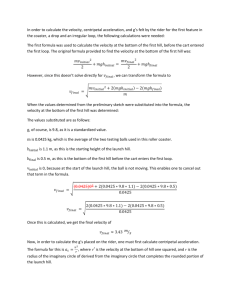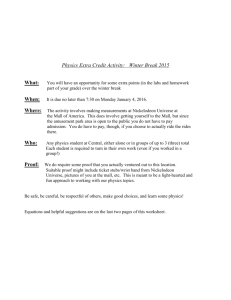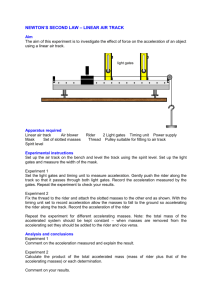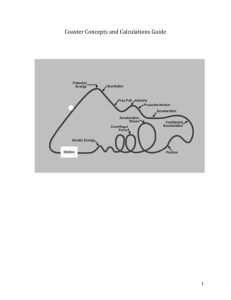CALCULATION OF THE G`S FELT in a loop
advertisement
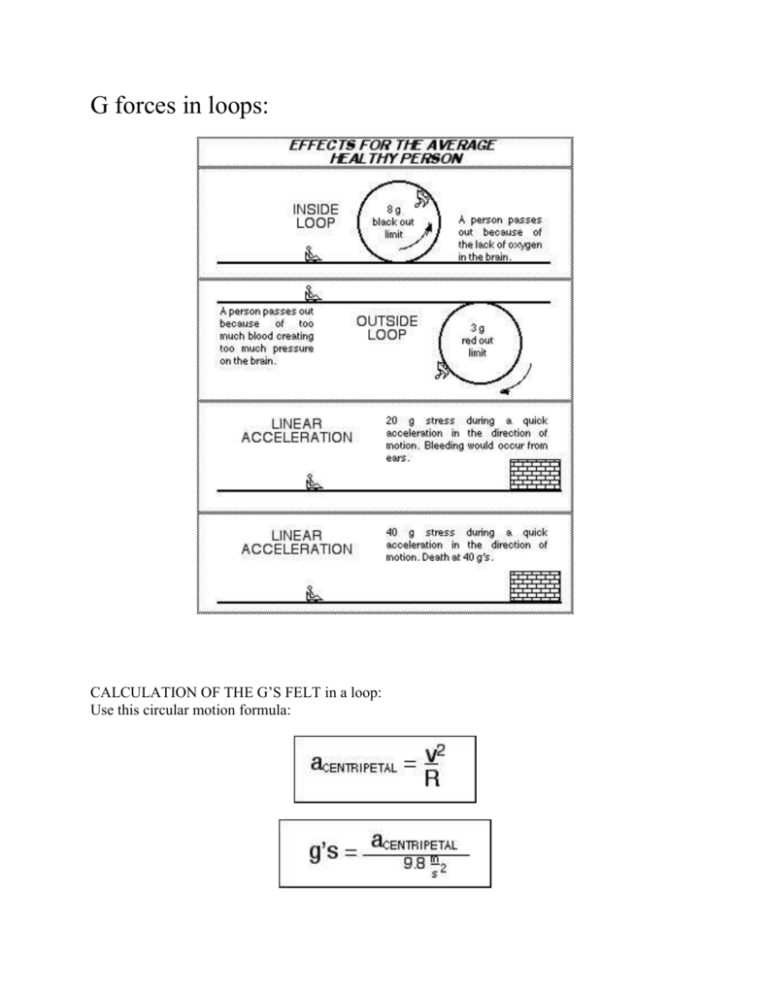
G forces in loops: CALCULATION OF THE G’S FELT in a loop: Use this circular motion formula: Where “v” is the velocity of the marble and “R” is the radius of the circle traveled. To calculate the velocity use the energy formula (KE + PE = KE + PE). One more thing: to calculate the g’s felt remember that the g’s felt by the rider is the normal force on the seat of the rider divided by the mass then converted into g’s. As a rider enters a loop he will feel 2 forces. The real number of interest is the number of g’s felt by the passenger traveling in the vertical circle. The g’s felt are affected by whether or not you are above or below the horizontal line. While above it the normal force is above you pushing down and while below it the normal force is beneath you pushing up. Regular, Circlular Loop Example: SOLUTION To calculate the g’s at the top of the loop, you will need to know the velocity of the rider there. To find velocity, use the total energy formula. Energy at the top has to equal energy at the bottom. KE (at top)+ PE(at top) = KE(at bottom) + PE(at bottom) KE = ½ mv2 PE= mgh ½ mv2 + mgh = ½ mv2 + 0 Notice how we have m (mass) on both sides of the equation. Neat math trick…you can take it out since it cancels itself out. So the new equation is: ½ v2 + gh = ½ v2 There are two velocities in the above equation. The first one is the velocity of the coaster at the top and the second one is the velocity of the coaster at the bottom. We know the velocity at the bottom so put it in (30) and solve for the other one (velocity at the top). ½ v2 + 9.8(17) = ½ (30)2 = 23 m/s at the top. Now let’s find the acceleration and g forces: acentripetal = v2/9.8 = (23)2/9.8 = 56 m/s2 G’s = 56/9.8 = 5.7 g’s but G’s felt = 5.7 g’s – 1 g (because we are on the top of the loop) = 4.7 The rider will not pass out because 4.7 is less than 8 g’s. The irregular loop example: The circular loop is easy enough to calculate. The irregular shaped loop needs a little more work. The velocity as the car enters the loop should be known. First establish the g’s that you want the rider to feel at the bottom. Subtract one g for what the track exerts. Then convert these g’s back to acceleration (just multiply your g force by 9.8) EXAMPLE STEP 1 (I’m randomly choosing 6 g’s as the limit for the rider) Therefore the centripetal acceleration of the track is 6g - 1g = 5g’s because we are above the horizon. STEP 2 (convert these g’s to m/s2) STEP 3 Now to calculate what the rider feels at the top of the loop. Decide on the height of the loop. Then decide how many g’s the rider will experience. Use the loop formula with centripetal acceleration to calculate the radius. STEP 4 The top of the loop will be at 25 m. (Chosen pretty much at random.) STEP 5 I’m randomly choosing 6 g’s again as the limit for the rider. It could be almost any number. At the top of the loop add 1 g for the centripetal force. (“Add” because the rider is upside down, above the horizon.) 6g’s + 1 g = 7g STEP 6 convert g’ to m/s2 STEP 7 (1/2)(m)(35)2 = (1/2)(m)vo2 +(m)(9.80 m/s2)(20 m) The m’s divide out. (1/2)(35)2 = (1/2)vo2 +(9.80 m/s2)(20 m) vo = 28.86 m/s STEP 8 Calculate the radius at the top In reality, a person will not pass out the instant he/she reaches 8 g’s. It will take a few seconds of being at 8 g’s for the person to pass out. But for the sake of easy calculations we will assume that the instant 8 g’s is reached a person will pass out. 8 g’s is an average. people generally pass out between 6 to 10 g’s. (FYI: The 40 g mark mentioned earlier is instantaneous for death.)
